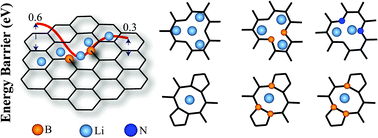Boron Doped Defective Graphene as a Potential Anode Material for Li-ion Batteries
슈퍼관리자
2021-05-21
Boron Doped Defective Graphene as a Potential Anode Material for Li-ion Batteries
-
Authors :
Rahul P. Hardikar, Deya Das, Sang Soon Han, Kwang-Ryeol Lee, Abhishek K. Singh
-
Journal :
Phys. Chem. Chem. Phys.
-
Vol :
16
-
Page :
16502-16508
-
Year :
2014

Abstract
AbstractGraphene with large surface area and robust structure has been proposed as a high storage capacity anode material for Li ion batteries. While the inertness of pristine graphene leads to better Li kinetics, poor adsorption leads to Li clustering, significantly affecting the performance of the battery. Here, we show the role of defects and doping in achieving enhanced adsorption without compromising on the high diffusivity of Li. Using first principles density functional theory (DFT) calculations, we carry out a comprehensive study of diffusion kinetics of Li over the plane of the defective structures and calculate the change in the number of Li atoms in the vicinity of defects, with respect to pristine graphene. Our results show that the Li–C interaction, storage capacity and the energy barriers depend sensitively on the type of defects. The un-doped and boron doped mono-vacancy, doped di-vacancy up to two boron, one nitrogen doped di-vacancy, and Stone–Wales defects show low energy barriers that are comparable to pristine graphene. Furthermore, boron doping at mono-vacancy enhances the adsorption of Li. In particular, the two boron doped mono-vacancy graphene shows both a low energy barrier of 0.31 eV and better adsorption, and hence can be considered as a potential candidate for anode material.
















